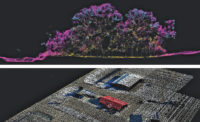An effort to create wetlands out of dry chaparral in the Arizona desert has begun two new phases of work to support emergent marshes completed last year.
The three-phase, $230-million Tres Rios Ecosystem Restoration and Flood Control Project is designed to improve a seven-mile-long section of the Salt and Gila rivers in southwestern Phoenix. The U.S. Army Corps of Engineers project is being built in coordination with the City of Phoenix.
The wetlands are sustained using reclaimed water from the city’s 91st Avenue Wastewater Treatment Plant, near the convergence of the Salt, Agua Fria and Gila rivers.
Last May, Archer Western of Atlanta won a $21.8-million, design-build contract for a secondary effluent pump station within the treatment plant. Work began in October and is slated for completion in February 2012, says Gwen Meyer, project manager with the Corps of Engineers.
The station will operate in concert with a similar, adjacent pump at the treatment plant to divert all effluent water to the Tres Rios Wetlands. It will have an initial capability of 300 million gallons per day and is designed to handle double that with future upgrades, says Kory Burden, project manager at Archer Western.
The station uses a Corps’ type 10 form suction intake, modified to fit a constrained site. “We confirmed the hydraulic performance of the intake through physical modeling,” says Dusan Stanisic, project manager with Phoenix-based Damon S. Williams Associates, the prime engineer on both the wetlands and the pump station. “It was a key element of ensuring correct flow into the pump intake so we don’t cause premature wear and lose efficiency.”
The station will help feed water to 480 acres of wetlands completed by Archer Western last year under a separate contract that also called for another 100 acres of land-based features to support the water system and ensure its stability. “Roughly 2.6 million cubic yards of earth was moved during construction,” Burden says. Crews also cleared 7,000 tons of household waste.
Able to sustain up to 480 million gallons of effluent water and rainwater per day, the restored wetlands also assist with flood control in the nearby rivers. However, water flow from the treatment plant has been lower than expected due to the number of vacant homes nearby, Stanisic says. “We’ve had to carefully manage water flow to the wetlands to make sure the plant life starts to develop,” he says.
The third phase restores the Salt and Gila riverbeds adjacent to the wetlands. The first of three contracts for the work was awarded to Kiewit Pacific Co., Omaha, Neb., in June. The $11.1-million job involves the construction of open water, wetland marshes and riprap corridors on a 1.5-mile stretch of the rivers. The work will also focus on the removal of a non-native plant, the salt cedar, which has overgrown the riverbeds.
The other two contracts will restore seven miles of the waterway once funding becomes available. “Since we are currently in continuing resolution, we are still not sure of the funding Tres Rios will receive for fiscal year 2011,” Meyer says.
Article toolbar




Post a comment to this article
Report Abusive Comment